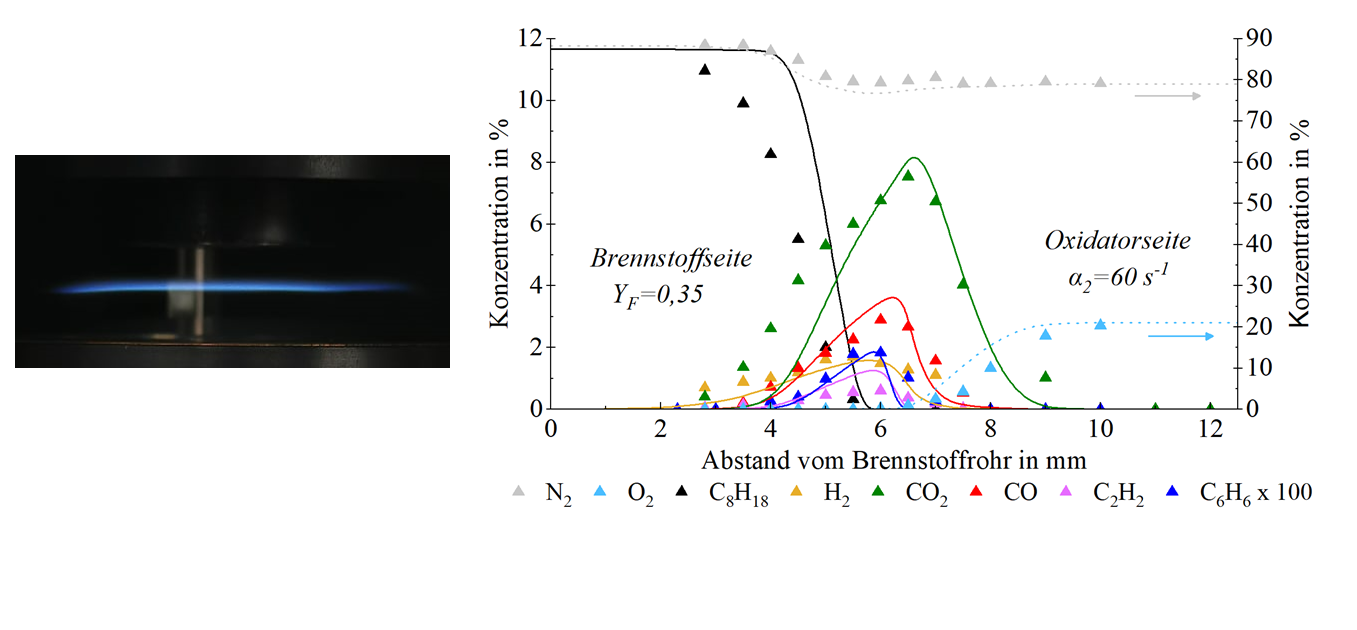Emissions Soot Model
The EU-H2020 project "Emissions Soot Model" (ESTiMatE) addresses the problem of emissions under lean-burn conditions, especially in aero engines, and focuses on the development of accurate and reliable pollutant formation prediction methods with a focus on soot. For more information on the fundamental idea of the project, the consortium, and project-related publications, see https://estimate-project.eu.
This requires the improvement or development of sophisticated models for the sub-processes concerned and validation against reference experiments to ensure reliable prediction of soot emissions. The aim of the work of the Combustion Technology Sub-Institute within the project is to generate data sets under representative combustion conditions that can be used to validate the developed models.
In this regard, laminar counterflow flames of a kerosene surrogate and its individual components (e.g., dodecane and iso-octane) are fundamentally investigated to decipher the influence of fuel composition on flame structure and, in particular, on the formation of soot precursors [benzene (A1), naphthalene (A2), pyrene (A4), etc.] and soot particles. The data obtained are first compared with previously developed chemical reaction models and then used to validate the models developed in ESTiMatE. The figure shows experimental and numerically calculated concentration curves of gaseous species in a non-premixed counterflow flame of iso-octane.
Within this framework, both intrusive and non-intrusive (optical) techniques are employed. While the gas phase composition is analyzed via gas chromatography coupled with mass spectrometry, the soot volume fraction and the particle diameter are determined via two-color time-resolved laser-induced incandescence (2C-TiRe-LII). The application of different laser excitation wavelengths in 2C-TiRe-LII enables the derivation of optical particle properties as well. In addition, a developed aerosol probe allows the sampling and characterization of very small particles during their formation.

Related literature:
- From molecular to sub-μm scale: The interplay of precursor concentrations, primary particle size, and carbon nanostructure during soot formation in counter-flow diffusion flames Hagen, F. P.; Vlavakis, P.; Bockhorn, H.; Suntz, R.; Trimis, D. 2023. Combustion and Flame, Article no: 112729. doi:10.1016/j.combustflame.2023.112729
- Soot nanoparticle sizing in counterflow flames using in-situ particle sampling and differential mobility analysis verified with two-colour time-resolved laser-induced incandescence Hagen, F. P.; Vlavakis, P.; Seitz, M.; Klövekorn, T.; Bockhorn, H.; Suntz, R.; Trimis, D. 2022. Proceedings of the Combustion Institute. doi:10.1016/j.proci.2022.07.253

